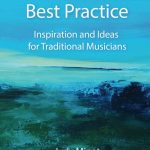Allegro
Book review: “Best Practice: Inspiration and Ideas for Traditional Musicians” by Judy Minot
Volume 121, No. 10November, 2021

BOOK REVIEW: “Best Practice: Inspiration and Ideas for Traditional Musicians,” by Judy Minot (Asbury, NJ, TradBridge Press), 2021 ISBN 978-578-87044-1 , 249 pp.
When I first came across this intriguing title, I assumed it referred to musicians like me, involved with traditional “classical” music. That merely shows my ignorance of one of the most vital music movements in the United States today, known among its adherents as “Trad.” Author Judy Minot is deeply involved with the practice of music that is traditionally learned and transmitted person to person by ear and by example. It is music that comes from a particular geographical region, is a social form of music making usually taking place within groups, and almost always suitable for dancing. But a great deal of what Minot has to say is relevant to any kind of musician. The word “inspiring’ in the title is not self-aggrandizement, but a realistic description of what is a most unusual work.
“Best Practice” was written for adult amateur, probably self-taught players, a primer on how to practice, how to learn, how to reach a goal. But practicing, learning, and reaching goals, are enterprises shared by all who play an instrument or engage in any kind of physical skill regardless of what stage they are in; hence the beauty of this book.
Minot has organized “Best Practice” as a series of thoughts dealing with the great variety of issues involved in playing an instrument. She calls each of these thoughts a “chapter,” and there are 197 of them. That makes for a very daunting table of contents, but each “chapter” is a few paragraphs at most, and usually less than one page. The table of contents is in fact a very useful index-outline; items don’t need to be read or practiced in sequence. The thoughts are a distillation of her own experience of having had piano lessons since childhood, her subsequent experiences as a student and then teacher of yoga and aikido, and above all her experience as a beginner accordion player at the age of 52, and fiddle player at age 54, when her interest in trad music drove her there. Every chapter ends with a little summary of the hoped-for goal, a helpful way to stay focused while practicing the particular skill.
Most of us reading this review will have been trained in music as children, when we were used to being beginners. It is different for adults, and as this book is meant for adults Minot has a lot to say about reacting to mistakes, to bad sound, to perceived failure, to insecurity about our abilities, to the mind-body interaction that can make things better or worse. But these issues, while perhaps more hidden, are not different for us grown-up professionals, and her suggestions about how to deal with them are relevant and helpful. She has all sorts of good ideas about how to practice — “shifting gears”, switching from “what I know” to “what I can learn,” “how to listen,” “interleaving” (using a variety of material alternatively to learn something).
Above all Minot reminds us of the need to become our own teacher in addition to whatever coaching is available. I am reminded of Malcolm Bilson, that most musical pioneer of the period-instrument movement, who as a student often found himself at odds with what he was being taught at the Vienna Academy about the music of Haydn, Mozart, Beethoven, and Schubert. His self-study allowed him to better understand the meaning of the details of the written music, to make key contributions to the restoration of the fortepiano to the concert stage and to produce fresh recordings of the mainstream repertory. No doubt we have all self-taught to some extent, experimented with one way or other to achieve the result we want. What Minot does is to provide encouragement and a variety of helpful techniques.
This is a friendly book with a wealth of ideas. If I were still teaching it would inspire my approach to my students, young or adult. I decided to write this review of “Best Practice” because I enjoyed it so much myself.
“Best Practice” includes an introduction, notes to the text, five appendices, and a detailed index.
Styra Avins has been a member of Local 802 since 1961.
